
Bhs1975
-
Posts
207 -
Joined
-
Last visited
Content Type
Profiles
Blogs
Forums
American Weather
Media Demo
Store
Gallery
Posts posted by Bhs1975
-
-
The sun was 0.6-0.7% brighter 65 million years ago. You don't need as much CO2 for a given temperature this time around.
Antarctica glaciated around 650ppm, but my guess is that due to solar luminosity increases, you'd only need around 550-600 to deglaciate it this time around.
Humans do not appreciate just how late in the game we showed up and how lucky we are for CO2 to be as (relatively) low as it is now. Another 200-300m years and this planet is going to be a permanent hothouse.
You mean dimmer in the past. High CO2 is what kept Earth from staying frozen before life evolved to help pull the CO2 out and now that the Sun is getting hotter we have to keep it below 350ppm to keep a stable climate. That major dip in CO2 at the end is when modern humans showed up and started migrating. -
It seems like that temperature dip was necessary for human life to come around and flourish in the first place. What's true in the present day is that humanity can't support itself in an ice-free world. 2 billion people rely on glaciers for drinking water, power, and agriculture.
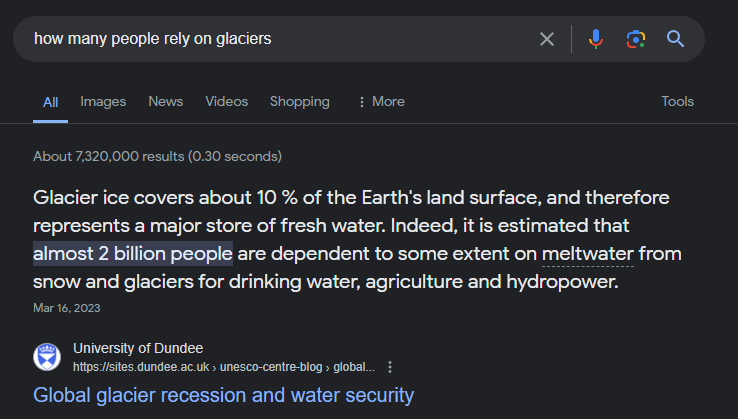
Yeap population will definitely drop.
. -
Humans and most plants and animals living today couldn't survive in those conditions. Only cold blooded reptiles and dinosaurs that are semi cold blooded would be able to keep from over heating. If we get to 800ppm CO2 that's where we would end up.
.-
 2
2
-
 1
1
-
-
Related to the CO2 fertilization post above, the recent study below accounted for the albedo effect of planting trees. In many places around the world, planting trees causes warming, as increases in absorbed sunlight offset the benefit from CO removal.
https://www.nature.com/articles/s41467-024-46577-1
So we would have to remove it using renewables and sequester it underground by using reactions to form limestone.
.-
 1
1
-
 1
1
-
-
Good afternoon CW. I read every one of your posts and value the civil interaction demonstrated by the different positions. I’m not qualified to speak technically but I find the example above, if I’m looking at it correctly, reflects a period of tine that was known as the dust bowl era. The effects were attributed to practices that ignored any present day sense of conservation. As a species we do seem to have the power to manipulate for the good and sadly for the bad. Please continue to post with civility as you have and I will certain read all and the responses. Never fear I do understand the ‘read more, post less axiom’ stay well, as always ….
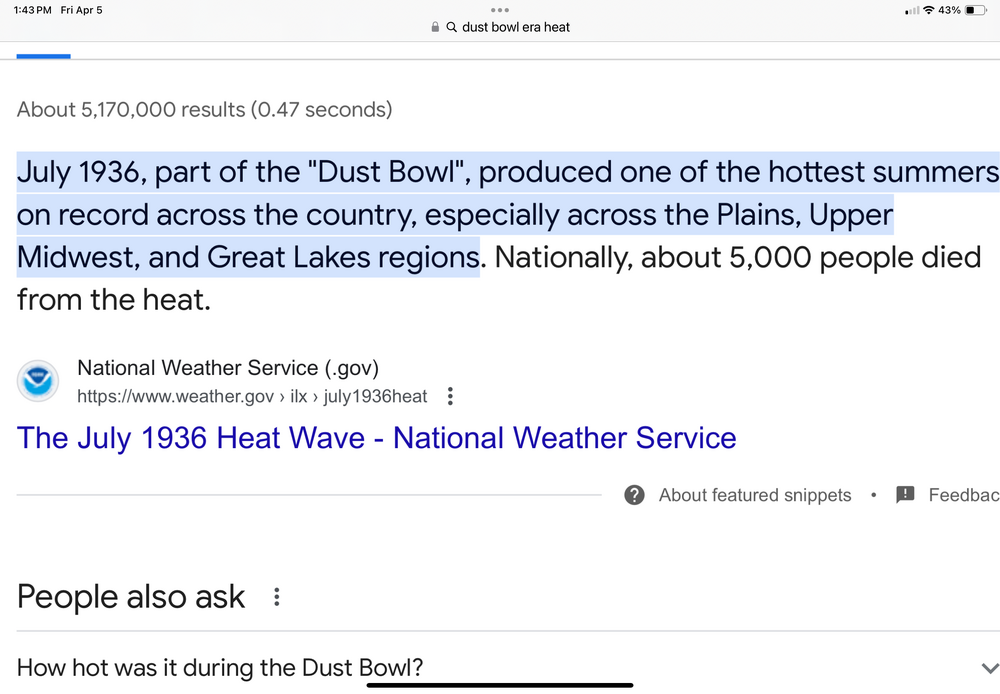
That goes to show you that if we greatly changed our land use practices and covered as much as possible with plants it would suck down an enormous amount of CO2 and cool the climate by blocking the sunlight from heating the ground.
.-
 1
1
-
 1
1
-
-
Not many folks care about a lake freezing less but they will care when those trillions of dollars of multimillion dollar properties get swallowed up by the ocean.-
 1
1
-
-
Remember 10 years ago, when every denier was crowing about "flat temps since '98", increasing Antarctic sea ice and an impending "grand solar minimum"?
Imagine saying that, then looking at this graph and *still* wanting to short sell it.
We'll be 2C by 2030 easily.-
 1
1
-
-
The disasters will become so catastrophic and numerous that funds will run out for recovery and folks will mass migrate to less affected areas which will collapse the system. Humans will become nomadic again.
-
 2
2
-
-
That’s what’s so impressive about this is the type of damage modern well built structures took. Not many examples come to mind especially with the high rise damage. There’s no question those taller structures took 200+ mph gusts to produce what we’re seeing. Think about Laura and lake Charles. That was a cat 4 with gusts to near cat 5 measured in the city and those high rises had mostly window damage. This completely gutted entire floors and any windward facades are just gone. It’s not just one building either, it’s all of them. I don’t even think there’s a remote comparison to this storm given the city it hit
I've always wondered what Cat 5+ winds would do to a high rise building. Looks like we'll be seeing a lot more of this. -
Looks like we are going to commit climate suicide and the only solution is collapse which would set us back to before the industrial revolution.
-
 3
3
-
-
There is an EQ swarm occurring near Ojai, CA.
Could be from heavy rain
. -
Really can’t believe there isn’t more discussions around this. This is likely something we won’t see again in our lifetimes and the interior flooding has a chance, as stated, to be 1000 year event.
it’s kind of like the rareness of Ophelia a few years ago nearly making it to Ireland as tropical.
I bet we will. Climate chaos.
. -
-
Quite a few of the GFS runs have been showing a CAG like storm forming in the western Caribbean. CMC has been showing it a lot too and now EPS is hinting it at. Where it goes from there is a toss up but the fact that it forms on many models is what's important.
If it does it will be over the highest OHC in the basin. -
Should the CFS due to its inferiority be ignored? For at least two runs, it has shown a TS moving into the NE Caribbean late week while no other operational shows any TC.
Yes-
 1
1
-
-
So if we drastically lowered emissions and irrigated and grew plants on as much available land as possible it would both provide a cooling effect and draw down huge amounts of CO2.
-
Look how much cooling of the extreme warmth of the SSTs shown by the buoys in/near shallow FL Bay occurred between late Monday afternoon's highs and this morning's lows just from a weak surface trough causing a significant increase in showers (the most rain in weeks) and much less sunshine (these are SSTs (F), not air temperatures):
Manatee Bay: from 101 to 84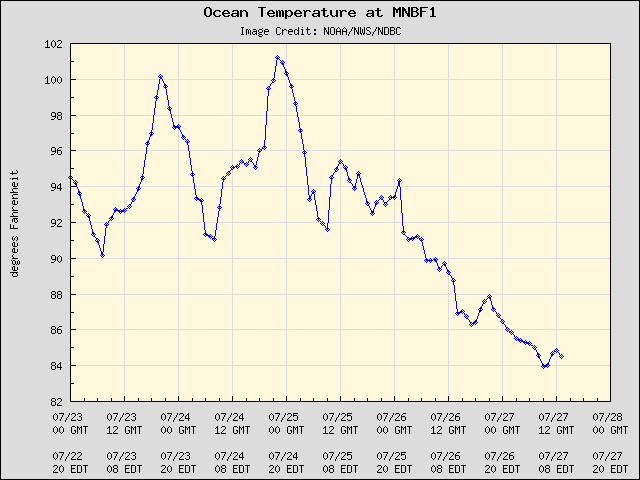
Johnson Key: from 98 to 79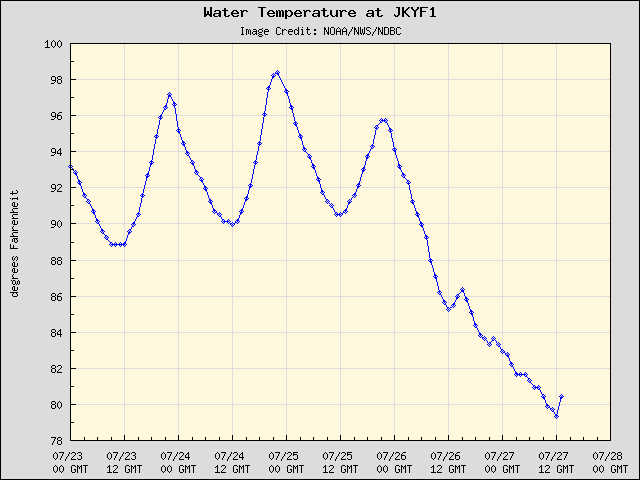
Murray Key: from 99 to 81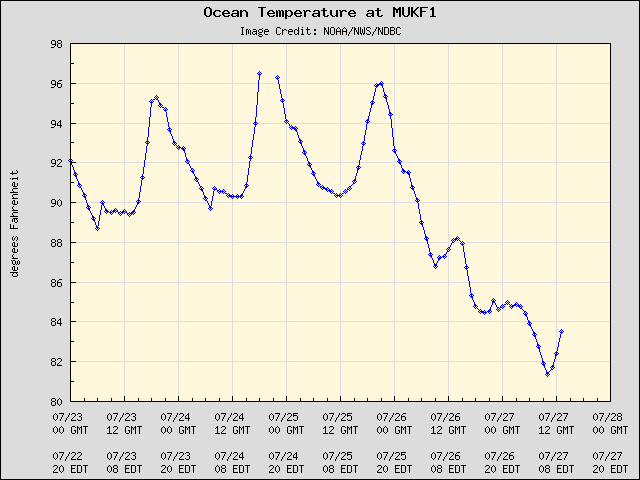
In contrast the Key West buoy, which is in deeper waters and thus has a much lower intraday range that is often only ~1F, cooled much less (from 92.3 to 89.6) and is still very warm: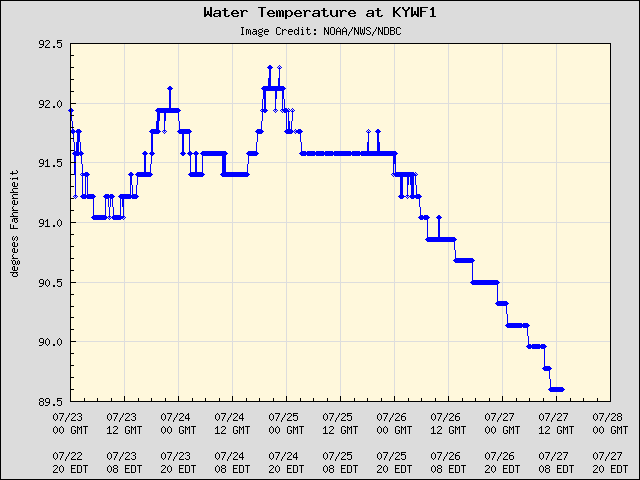
This is why canes lose their punch when they are slow to move over shelf waters.-
 1
1
-
-
That's like one of those therapeutic pools.
.
SSTs where over 100F in the tropics during the PETM. -
The Johnson Key buoy SST rose from 98.2 at 5PM to 98.4 at 6PM. This is the hottest I've seen it since I started following it earlier this month. Based on other sunny days, 6PM is typically the hottest hourly of this very shallow (5 ft) water.
That's like one of those therapeutic pools.
.-
 1
1
-
-
Regarding the SST the Johnson Key buoy's low this morning was 1.1 warmer than yesterday meaning 90.0 (8AM). Today's 3PM SST of 96.1 is 1.3 warmer than the 94.8 of 24 hours ago. There's potentially still another 3 hours of SST warming with full sunshine and no showers anywhere nearby. Thus, there's a good chance that yesterday's 97.2 SST high will be exceeded today.
Edit: An hour later (4PM) the SST rose from 96.1 to 97.5 with potentially another two hours of warming.
https://www.ndbc.noaa.gov/station_page.php?station=jkyf1
.-
 1
1
-
-
We're not yet to the point where we need to worry with WBTs. You need T/Tds of 100/85 or 115/80 type temps to hit dangerous levels (>31C WBTs) and 115/90 or thereabouts for true, hard habitability limits. 100/85 seems reachable in a few select areas for brief times, but Tds of near 90 don't seem possible yet.
Persian gulf.
. -
Looks like your the only one here spouting denier nonsense.
-
 1
1
-
-
The arctic can go ice free all year? Based on what evidence?
but but… Al gore said it would be ice free in 2008. Why isn’t it ice free now?
how gut hooked do you have to be to believe the arctic can be open water all year?
It was a swamp with alligators and palms during the Cretaceous.-
 2
2
-
-
if anything the IPCC predictions have been way too conservative
Yeap the massive disruptions will only accelerate degrading civilization to some unknown breaking point.

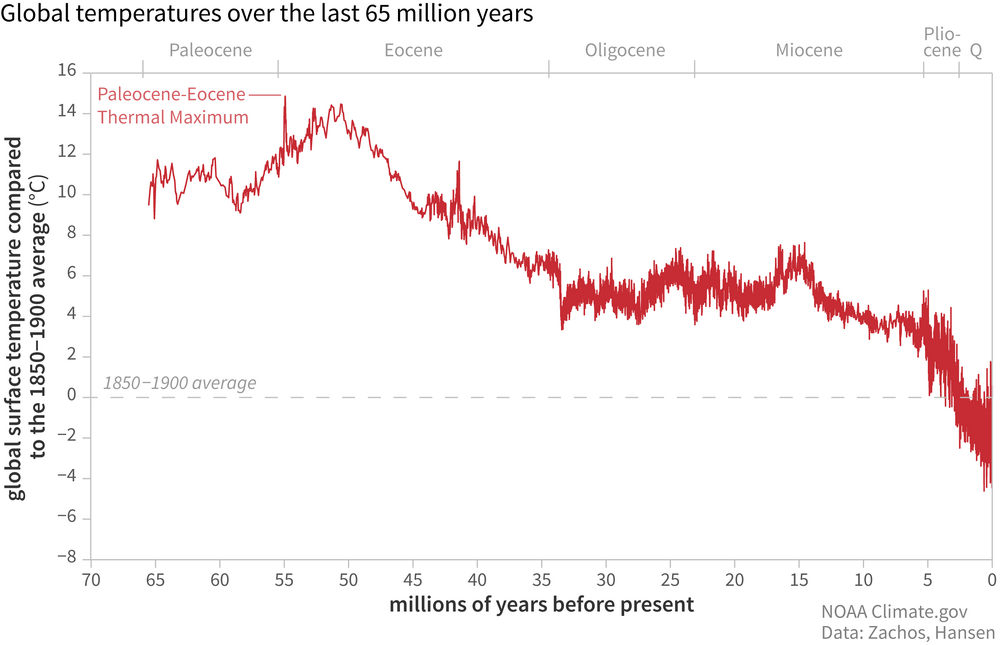

Occasional Thoughts on Climate Change
in Climate Change
Posted
Collapse would occur well before 2.9C.